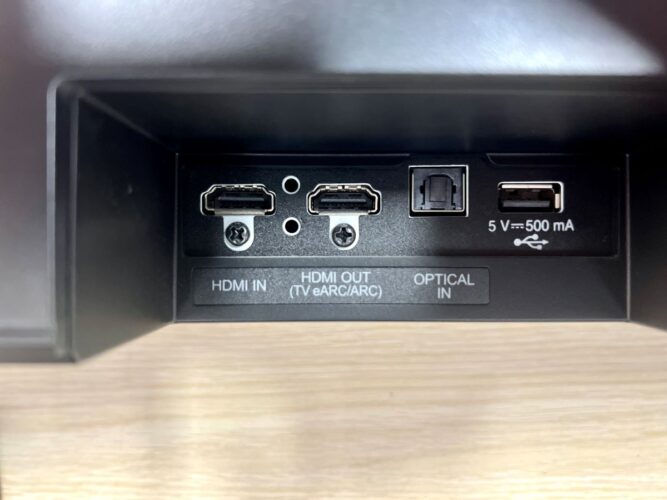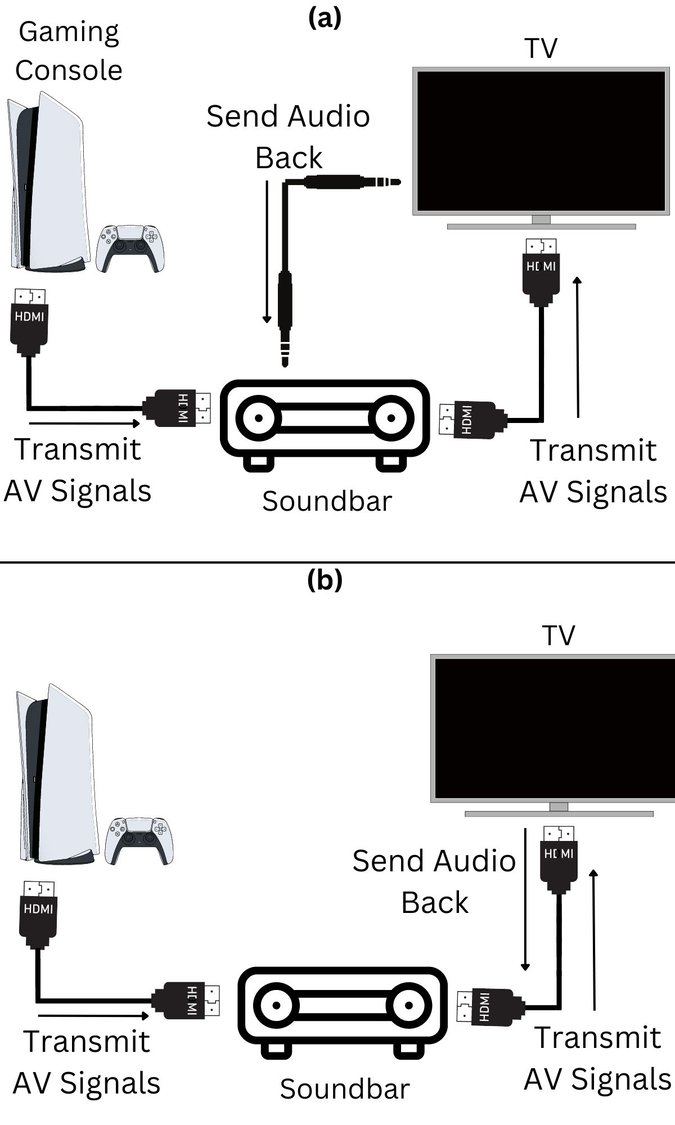HDMI ARC vs. Regular HDMI: Breaking Down the Differences

What To Know
- HDMI ARC, introduced with HDMI 1.4, streamlines AV connections by enabling two-way audio with a single cable.
- HDMI ARC functionality requires cables and devices compatible with HDMI 1.4 or higher; no special cables are needed.
- HDMI eARC, an enhancement over ARC in HDMI 2.1, supports advanced audio formats and higher bandwidth for superior sound.
This article sheds light on the nuances between standard HDMI and ARC-enabled interfaces, offering clear insights to optimize your home theater setup.
Quick Navigation
What is HDMI ARC/eARC?

ARC (Audio Return Channel) is a feature added to the HDMI standard with v1.4 or above. An HDMI ARC port is labeled “ARC” for easy identification.
An HDMI ARC port or cable appears and functions the same as a regular HDMI cable but has a “return channel,” which allows audio information to travel both ways and eliminates the requirement for a discrete audio connection.
Note that traditional HDMI supports only one-lane transmission of audio-video signals between a source and a display device.
HDMI ARC can transmit different audio formats, such as uncompressed stereo, DTS, and Dolby Digital.
Note that ARC works if all connected devices (audio, TV, etc.) support the feature. The same is the case with eARC.
HDMI eARC is “enhanced” HDMI ARC. It supports advanced audio formats and higher bandwidth. ARC doesn’t support Dolby Atmos natively, but eARC does.
Besides, there are many other ways HDMI eARC improves upon ARC. More on that later.
HDMI vs. HDMI ARC: Breaking Them Down
HDMI ARC’s foundation is in HDMI. But ARC is so extremely handy; anything before it is now obsolete. From simplified audio setups to HD video transmission, the following are ways in which HDMI ARC betters HDMI.
Less Number of Cables in AV Setup
HDMI ARC uses fewer cables in an AV setup than traditional HDMI since ARC doesn’t require an extra audio cable.
In our example, we suppose a gaming console is the source device, the soundbar the output device, and the TV the display device.
Below are the AV setup diagrams before and after the advent of HDMI ARC:

(a) before the introduction of HDMI ARC; (b) after the introduction of HDMI ARC
| Before the introduction of HDMI ARC (HDMI 1.3 or below) | After the introduction of HDMI ARC (HDMI 1.4 or above) |
| AV source connection: Hook the first HDMI cord to the soundbar and gaming console. It will transmit audio-video signals. | AV source connection: Use an HDMI cable to connect the soundbar and gaming console to transmit audio and video signals. |
| Video connection: Incorporate another HDMI cord, connecting the TV and soundbar. As non-ARC HDMI cannot demarcate audio-video signals and sends them together, you’ll need an audio return cord to transmit audio signals to the soundbar. | Audio return connection: Use another HDMI cord to the TV and soundbar. The cable shall send AV information to the TV from the gaming console and transmit back audio signals to the soundbar.
|
| Audio return connection: Connect a 3.5mm or optical audio cable to the soundbar and TV to transmit only audio signals from the TV back to the soundbar. |
Different Specifications
Although HDMI cables, ports, and connectors haven’t changed much externally, their specifications differ. The HDMI 1.4 or above version that ARC requires to work is not the same as the immediately preceding and now obsolete HDMI 1.3 or below version.
Here is a table listing all HDMI versions and their key specifications:
| HDMI Versions | Maximum Resolution at Refresh Rate | Bandwidth (Gbit/s) | HDR |
| HDMI 1.0 | 1080p @ 60 Hz | 4.95 | No |
| HDMI 1.1 | 1080p @ 60 Hz | 4.95 | No |
| HDMI 1.2 | 1440p @ 30 Hz | 4.95 | No |
| HDMI 1.2a | 1440p @ 30 Hz | 4.95 | No |
| HDMI 1.3 | 5K @ 30 Hz (1) | 10.2 | No |
| HDMI 1.4 (ARC starts to be included) | 5K @ 30 Hz (1) | 10.2 | No |
| HDMI 1.4a | 5K @ 30 Hz (1) | 10.2 | No |
| HDMI 1.4b | 5K @ 30 Hz (1) | 10.2 | No |
| HDMI 2.0 | 8K @ 30 Hz (1) | 18.0 | No |
| HDMI 2.0a | 8K @ 30 Hz (1) | 18.0 | Yes |
| HDMI 2.0b | 8K @ 30 Hz (1) | 18.0 | Yes |
| HDMI 2.1 (eARC starts to be included) | 10K @ 120 Hz (2) | 48.0 | Yes |
| HDMI 2.1a | 10K @ 120 Hz (2) | 48.0 | Yes |
| HDMI 2.1b | 10K @ 120 Hz (2) | 48.0 | Yes |
(1): Possible by using Y′CBCR with 4:2:0 subsampling; (2): Possible by using Display Stream Compression (DSC)
Bonuses
Are There HDMI ARC Cables?
Yes, there are HDMI ARC cables. Technically speaking, all cables supporting HDMI 1.4 standards or greater are HDMI ARC cords.
Cables that support up to HDMI 1.3 are not HDMI ARC cables since the ARC feature is only added to HDMI cables v1.4 or higher.
And HDMI 1.3 is now obsolete, so all HDMI cables available on the market belong to v1.4 and subsequent standards.
That means even if you’re shopping for an HDMI ARC cable unaware of the minimum HDMI 1.4 base standard requirement, you’d still buy the suitable HDMI cable.
How is HDMI eARC More Enhanced Than HDMI ARC?
HDMI ARC was undoubtedly a significant improvement over non-ARC HDMI or optical audio connections. But it wasn’t perfect.
For instance, it needed more resources to handle lossy Dolby Atmos. ARC instead supports Dolby Digital Plus, Atmos’ lossy version.
The table below showcases other aspects in which eARC is better than ARC.
| HDMI ARC | HDMI eARC | |
| HDMI Standard | HDMI 1.4 (or higher) | HDMI 2.1 (or later) |
| Cable | High-Speed HDMI | Ultra High-Speed HDMI |
| Maximum Audio Bandwidth | 1 Mbps | 37 Mbps |
| Maximum Audio Channels | 8 | 32 |
Notes:
- High-Speed HDMI and High-Speed HDMI with Ethernet are actual HDMI cable certifications. To learn more about the different HDMI cable classes, click here.
- eARC’s 37 Mbps bandwidth capability enables it to pass various high-resolution audio formats, such as Dolby True HD, DTS:X, Dolby Atmos (uncompressed), or DTS-HD Master Audio.
- The High-Speed HDMI with Ethernet cable will enable the eARC feature. However, to benefit from all HDMI 2.1 features, such as 48 Gbps bandwidth support and support for video resolutions of more than 4K and up to 10K at 120 Hz, an Ultra High-Speed HDMI cord will be needed.
- eARC offers the automatic lip-sync correction feature, ensuring that audio always aligns with the video. The feature can be found in ARC but is mandatory with eARC.
- Both HDMI ARC and eARC support stereo and compressed 5.1 audio, but the experience is the best with eARC. eARC supports uncompressed 5.1 and 7.1 audio formats.
Conclusion
ARC and eARC are not essential features. However, with TV manufacturers equipping their devices with serious features such as variable refresh rate, quick frame transport, 4K at 120 Hz, etc., it’s hard to use the TV without ARC/eARC.
HDMI ARC becomes superfluous if you only use your TV for video and audio and don’t use a soundbar or AV receiver.
But because most TVs don’t sound as good as dedicated external speakers, especially when watching movies, ARC and eARC that seamlessly connect TVs to soundbars and AV receivers become almost mandatory.
HDMI ARC added increased convenience and capabilities to audio transmission. eARC took that further with more bandwidth, higher-quality audio format support, broadened audio channel capacities, etc., catering to home theater enthusiasts and audiophiles seeking immersive audio experiences and lossless audio formats.
Long story short, ARC is a feature of HDMI. It is among the best features to come up in the home theater space in recent years, with the eARC raising the bar.
Catherine Tramell has been covering technology as a freelance writer for over a decade. She has been writing for Pointer Clicker for over a year, further expanding her expertise as a tech columnist. Catherine likes spending time with her family and friends and her pastimes are reading books and news articles.

